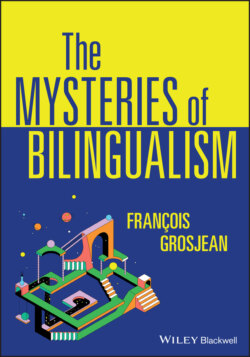The Mysteries of Bilingualism

Реклама. ООО «ЛитРес», ИНН: 7719571260.
Оглавление
Francois Grosjean. The Mysteries of Bilingualism
The Mysteries of Bilingualism
Contents
List of Figures
Guide
Pages
Author Biography
Introduction
1 Who Is Bilingual?
Definitions and Their Evolution. What Lay People Say
What Dictionaries Say
What Language Scientists Say
Describing Bilinguals
At a Particular Point in Time
Language History
Self-report Questionnaires
References
Notes
2 How Many Bilinguals Are There?
The Extent of Bilingualism
On the Difficulties of Counting People Who Are Bilingual
The Proportion of Bilinguals in a Number of Countries
The United States
Canada
European Countries
Estimating the Percentage of Bilinguals in the World
References
Notes
3 Bilingual Infants’ Journey to Language Separation
Perception Studies
Born with a Preference for Two Languages
Visual Language Information
Prosodic Information
Phonotactics
Sound Contrasts
Statistical Regularities
Taking Pragmatics into Account
A Brief Account of Language Separation
References
Notes
4 Having an Accent in One of Your Languages
General Aspects
The Phonetic Characteristics of Accents
How Well Is Accented Speech Understood?
Factors that Affect the Degree of a Foreign Accent
Maturational Aspects
Language Input
Motivation and Attitudes
Accent in a Third Language
References
5 Language Loss in Adults and Children
Language Loss in Adults
A Case Study
Manifestations of Language Attrition
In Search of Factors that Account for Language Loss
Language Loss in Young Children
Early Experimental Studies on Lost Languages
A Breakthrough in This Research
The Production of a Lost Language
References
6 Brain Injury and Bilingualism
A Personal Testimony
Language Impairment and Recovery in Bilingual Aphasia
Parallel Recovery
Differential Recovery
Blended Recovery
Selective Recovery
Successive Recovery
Two Rarer Patterns: Antagonistic, and Alternating Antagonistic, Recoveries
Factors that Account for Impairment and Recovery
First Language Acquired
Language(s) Used the Most
Age of Acquisition (AoA) of the Second Language
Other Language Factors
Affective Ties and Emotional Attitudes
A Recent Meta-Analysis
Language Mixing and Aphasia
References
Notes
7 The Bilingual’s Languages in Interaction
Choosing the Language of the Interaction. Factors Underlying Language Choice
Recent Studies that Have Looked at Some of These Factors
What Role for the Other Language?
Experimental Work on Language Mixing
The Language Mode Concept
References
Notes
8 What a Bilingual’s Languages Are Used For
What Past Research Has Revealed
Recent Interest in Bilingual Language Use
Measuring Bilingual Language Use
Language Use in Terms of Percentages or Scale Values
Language Use in Terms of Language Entropy and Network Analysis
Impact of Bilingual Language Use
Language Perception
Language Production
Language Acquisition
Memory
Mental Calculation and Mathematics
References
Notes
9 Is Language Processing in Bilinguals Selective or Non-selective?
Language Perception and Comprehension
Examples of Studies that Show Non-selectivity
Examples of Studies that Show Selectivity
Factors that Affect Whether Perception Is Selective or Not
Spoken Language Production
A Study that Showed non-selectivity
Studies that Show Selective Processing
A Brief Summary of Two Theoretical Frameworks
References
10 Bilinguals Who Are also Bicultural1
Describing Biculturals
Becoming Bicultural and the Evolution of Biculturalism over Time
Synchrony and Asynchrony of Bilingualism and Biculturalism
The Evolution of Biculturalism over Time
Acting Biculturally
Experimental Work
Bicultural Identity
References
Notes
11 Change of Language, Change of Personality?
Opinions and Beliefs
Pioneering Research on the Question
Feeling Different When Using Different Languages
Is a Change of Personality Involved When Changing Languages?
An Explanation
References
Notes
Index
WILEY END USER LICENSE AGREEMENT
Отрывок из книги
Unresolved Issues
François Grosjean
.....
The other variable that is influenced by language proficiency, language use, and functions of languages, is language dominance. For a long time, researchers asked themselves whether dominance was based on just proficiency, or use, or both, or whether it depended on basic skills such as reading and writing a language, or even whether it concerned when the languages were acquired. Silva-Corvalán and Treffers-Daller (2016) studied dominance extensively and came to the conclusion that a dominant language is that in which a bilingual has attained an overall higher level of proficiency at a given age, and/or the language which s/he uses more frequently, and across a wider range of domains. As we see, all three factors are mentioned in their definition.
A final factor that needs to be included when describing bilinguals at a particular point in time concerns biculturalism. Are the bilinguals being described also bicultural and, if so, what impact does it have on their bilingualism (Grosjean 2015). Chapter 10 is dedicated to biculturalism but it worth mentioning here that bilingualism and biculturalism are not automatically coextensive. You can find bilinguals who are not bicultural (e.g., those bilinguals who have lived in just one culture, such as many Dutch people), biculturals who are not bilingual (e.g., British people who have migrated to the United States), as well as people who are both bicultural and bilingual. Biculturals can be characterized in the following way: They take part, to varying degrees, in the life of two or more cultures; they adapt, in part at least, their attitudes, behaviors, values, languages, etc., to these cultures; and they combine and blend aspects of the cultures involved. Being bicultural has a real impact on language knowledge and language use in bilinguals. One example that comes to mind concerns concepts in the bilingual lexicon. So called translation equivalents, such as French “pain” and English “bread” may share the same concept in bilinguals who are not bicultural, but certainly not if they are bicultural. The same is true of French “café” and English “coffee.”
.....